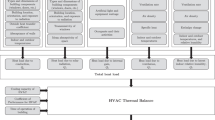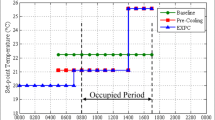Abstract
The air flow distribution characterizing conditioned indoor environments obtained following conventional design methodologies does not always guarantee both thermal comfort and indoor air quality (IAQ) for all occupants. This occurs because this air flow distribution depends on factors such as the air supply conditions, the grilles and diffusers position/size, and the environmental conditions. Accordingly, the aim of this work is to numerically study the influence of the air supply conditions and the positioning and size of air-conditioning system grilles on the thermal comfort and IAQ in indoor environments. For this purpose, an optimization scheme involving genetic algorithms and computational fluid dynamics techniques has been initially developed. Three objective functions have been next separately optimized, predicted mean vote—predicted percentage dissatisfied (PMV-PPD), percentage of dissatisfied due to draft (PD) and air change effectiveness (ACE). The optimal indoor environment configuration based on the PPD produces the best results in terms of thermal comfort (PPD = 6.6%, PD = 18.7%) indexes. This configuration also features the second lowest energy consumption (774 W). Furthermore, the configuration based on the ACE both presents PMV (≤ − 1.3) and PD (≥ 20%) values far from the acceptability criteria given by the standards, and involves the highest energy consumption (1832 W). Notice that the optimization of thermal comfort indexes implies indirectly optimizing the related systems energy demand as well. When using indexes such as PPD and PD as the optimization objective functions indeed, the total energy consumption is also reduced.


















Similar content being viewed by others
References
Costa, A., Keane, M.M., Torrens, J.I., Corry, E.: Building operation and energy performance: monitoring, analysis and optimization toolkit. Appl. Energy 101, 310–316 (2013)
Yang, L., Yan, H., Lam, J.C.: Thermal comfort and building energy consumption implications–A review. Appl. Energy 115, 164–173 (2014)
Sharma, S.S.: Determinants of carbon dioxide emissions: Empirical evidence from 69 countries. Appl. Energy 88, 376–382 (2011)
Ho, S.H., Rosario, L., Rahman, M.M.: Three-dimensional analysis for hospital operating room thermal comfort and contaminant removal. Appl. Therm. Eng. 29, 2080–2092 (2009)
Zhou, L., Haghighat, F.: Optimization of ventilation system design and operation in office environment, Part I: Methodology. Build. Environ. 44, 651–656 (2009)
Wang, J., Zhang, T., Zhou, H., Wang, S.: Inverse design of aircraft cabin environment using computational fluid dynamics-based proper orthogonal decomposition method. Indoor Built Environ 27(10), 1379–1391 (2017)
Huang, H., Ooka, R., Chen, H., Kato, S.: Optimum design for smoke-control system in buildings considering robustness using CFD and Genetic Algorithms. Build. Environ. 44, 2218–2227 (2009)
Zhai, Z., Xue, Y., Chen, Q.: Inverse design methods for indoor ventilation systems using CFD-based multi-objective genetic algorithm. Build. Simul. 7(6), 661–669 (2014)
Versteeg, H.K., Malalasekera, W.: An Introduction to Computational Fluid Dynamics. Pearson Educational Limited, London (2007)
Shih, T.-H., Liou, W.W., Shabbir, A., Yang, Z., Zhu, J.: A new k-ϵ eddy viscosity model for high reynolds number turbulent flows. Comput. Fluids 24(3), 227–238 (1995)
Awbi, H., Hatton, A.: Mixed convection from heated room surfaces. Energy Build. 32, 153–166 (2000)
Awbi, H., Hatton, A.: Natural convection from heated room surfaces. Energy Build. 30, 233–244 (1999)
Çengel, Y.A., Boles, M.: Thermodynamics: An Engineering Approach. McGraw-Hill, Newyork (2015)
Li, K., Xue, W., Xu, C., Su, H.: Optimization of ventilation system operation in office environment using POD model reduction and genetic algorithm. Energy Build 67, 34–43 (2013)
ASHRAE, ASHRAE Handbook-Fundamentals, Atlanta, ASHRAE (2013)
ANSI/ASHRAE, “Standard 55, Thermal Environmental Conditions for Human Occupancy,” ANSI/ASHRAE (2010). https://www.techstreet.com/ashrae
Fanger, P.: Thermal comfort: analysis and applications in environmental engineering, R.E. Krieger Pub. Co. (1982)
Fanger, P.O., Melikov, A.K., Hanzawa, H., Ring, J.: Air turbulence and sensation of draught. Energy Build 12, 21–39 (1988)
Fanger, P.O., Christensen, N.K.: Perception of draught in ventilated spaces. Ergonomics 29(2), 215–235 (1986)
ISO 7726. “Ergonomics of the thermal environment – Instruments for measuring physical quantities,” ISO (1998)
Chen, M.S.K., Fan, L.T., Hwang, C.L., Lee, E.S.: Air flow models in a confined space—a study in age distribution. Build. Sci. 4(3), 133–143 (1969)
Sandberg, M.: What is ventilation efficiency? Build. Environ. 16(2), 123–135 (1981)
Gan, G., Awbi, H.B.: “Numerical prediction of the age of air in ventilated rooms,” Roomvent '94 4th International conference on air distribution in rooms 15–28 (1994)
Novoselac, A., Srebric, J.: Comparison of Air Exchange Efficiency and Contaminant Removal Effectiveness as IAQ Indices. Transact. Am. Soc. Heat. Refrig. Air Cond. Eng. 109(2), 339–349 (2003)
Kumar Singh, N., Premachandran, B.: Analysis of turbulent natural and mixed convection flows using the v2–f model. ASME J. Heat Transfer. (2016). https://doi.org/10.1115/1.4032639
ANSYS, ANSYS Fluent User's Guide, Release 17.1 (2016). https://www.ansys.com/.
Fluent, “Gambit 2.4.6” (2004)
ANSYS, Inc, “ANSYS Fluent, ver. 17.1”, United States (2016). http://www.ansys.com
Mitchell, M.: An Introduction to Genetic Algorithms. Londres: Massachusetts Institute of Technology (1988)
Michalewicz, Z.: Genetic Algorithms + Data Structures = Evolution Programs. Springer, New York (1996)
Safe, M., Carballido, J., Ponzoni, I., Brignole, N.: “On stopping criteria for genetic algorithms,” advances in artificial intelligence – SBIA 2004. Lect. Notes Comput. Sci. 3171, 405–413 (2004)
Mathworks, Inc, “MATLAB R2017a” (2017). http://www.mathworks.com
Mathworks, Inc, “Matlab’s genetic algorithm and direct search toolbox” (2004). http://www.mathworks.com
Blay, D., Mergui, S., Niculae, C.: Confined Turbulent Mixed Convection in the Presence of a Horizontal Buoyant Wall Jet. Fundam Mixed Convect ASME HTD 213, 65–72 (1992)
Walikewitz, N., Jänicke, B., Langner, M., Meier, F., Endlicher, W.: The difference between the mean radiant temperature and the air temperature within indoor environments: A case study during summer conditions. Build. Environ. 84, 151–161 (2015)
Int-Hout, D.: Basics of well-mixed room air distribution. ASHRAE J. 57(7), 12–9 (2015)
Acknowledgements
This work was supported by the “Master’s Program in Peruvian Universities,” promoted by the Ministry of Education (MINEDU), the National Council of Science, Technology and Technological Innovation (CONCYTEC) and the National Fund for Scientific, Technological and Technological Innovation (FONDECYT).
Author information
Authors and Affiliations
Corresponding author
Ethics declarations
Conflict of interest
On behalf of all authors, the corresponding author states that there is no conflict of interest.
Additional information
Publisher's Note
Springer Nature remains neutral with regard to jurisdictional claims in published maps and institutional affiliations.
Rights and permissions
About this article
Cite this article
Angeles-Rodríguez, L., Celis, C. Numerical study and optimization of air-conditioning systems grilles used in indoor environments. Int J Energy Environ Eng 12, 787–804 (2021). https://doi.org/10.1007/s40095-021-00412-1
Received:
Accepted:
Published:
Issue Date:
DOI: https://doi.org/10.1007/s40095-021-00412-1




